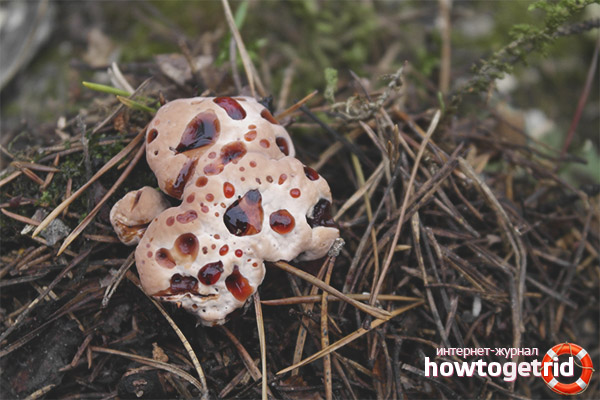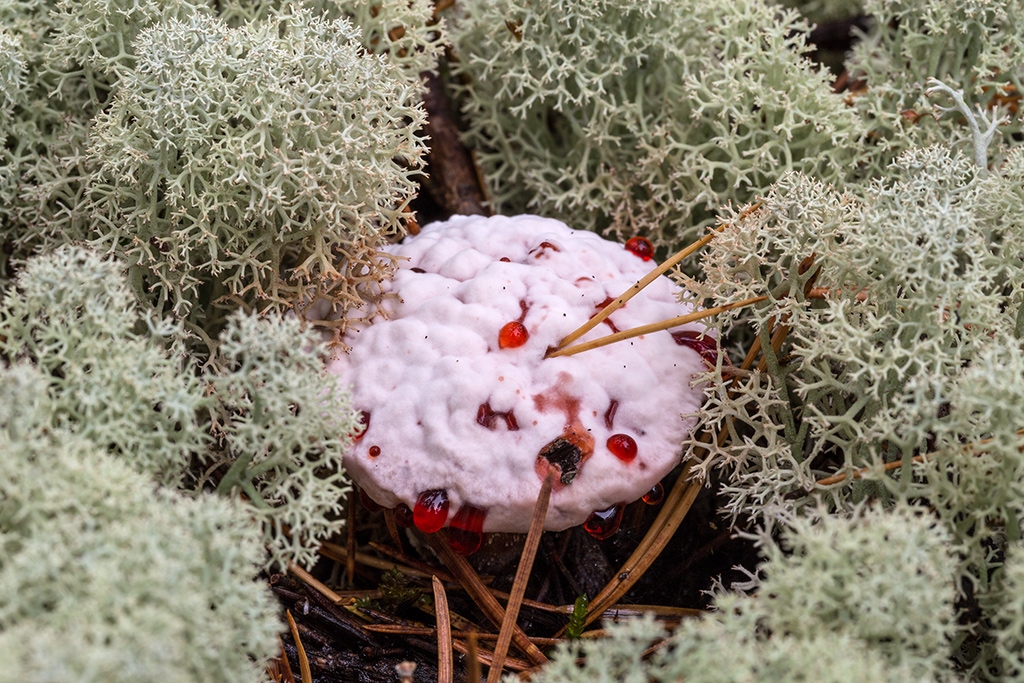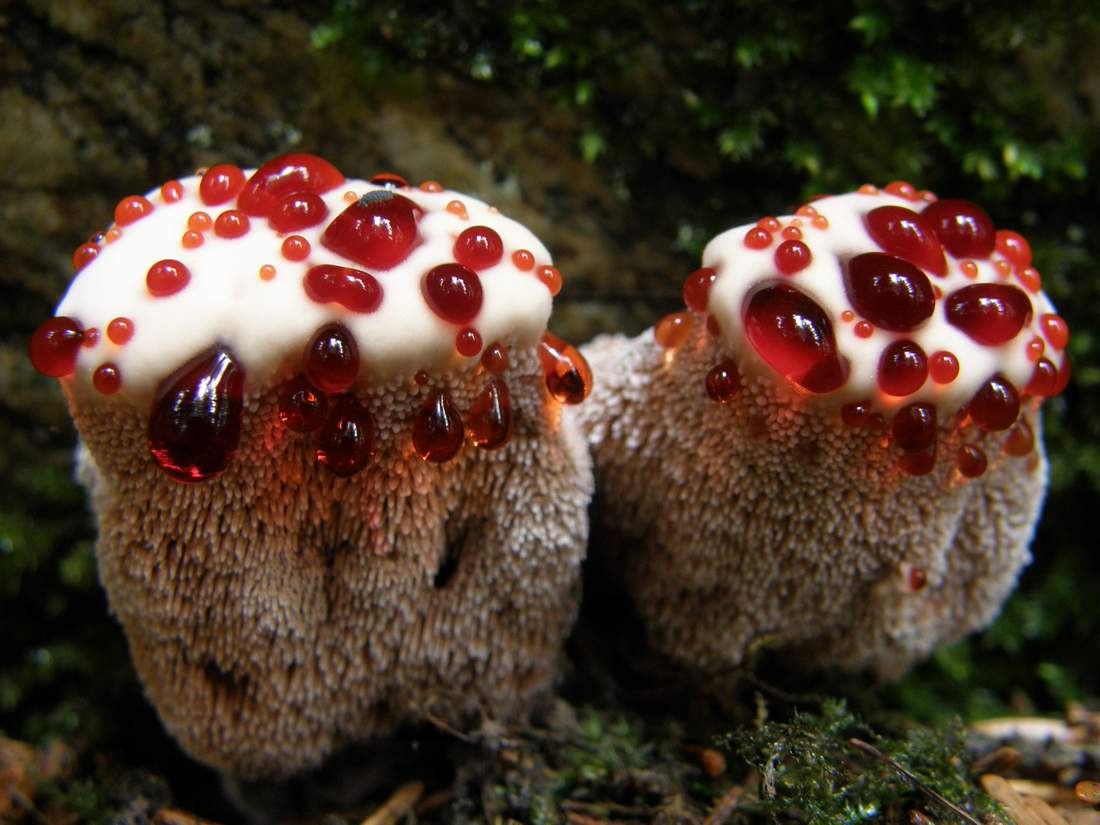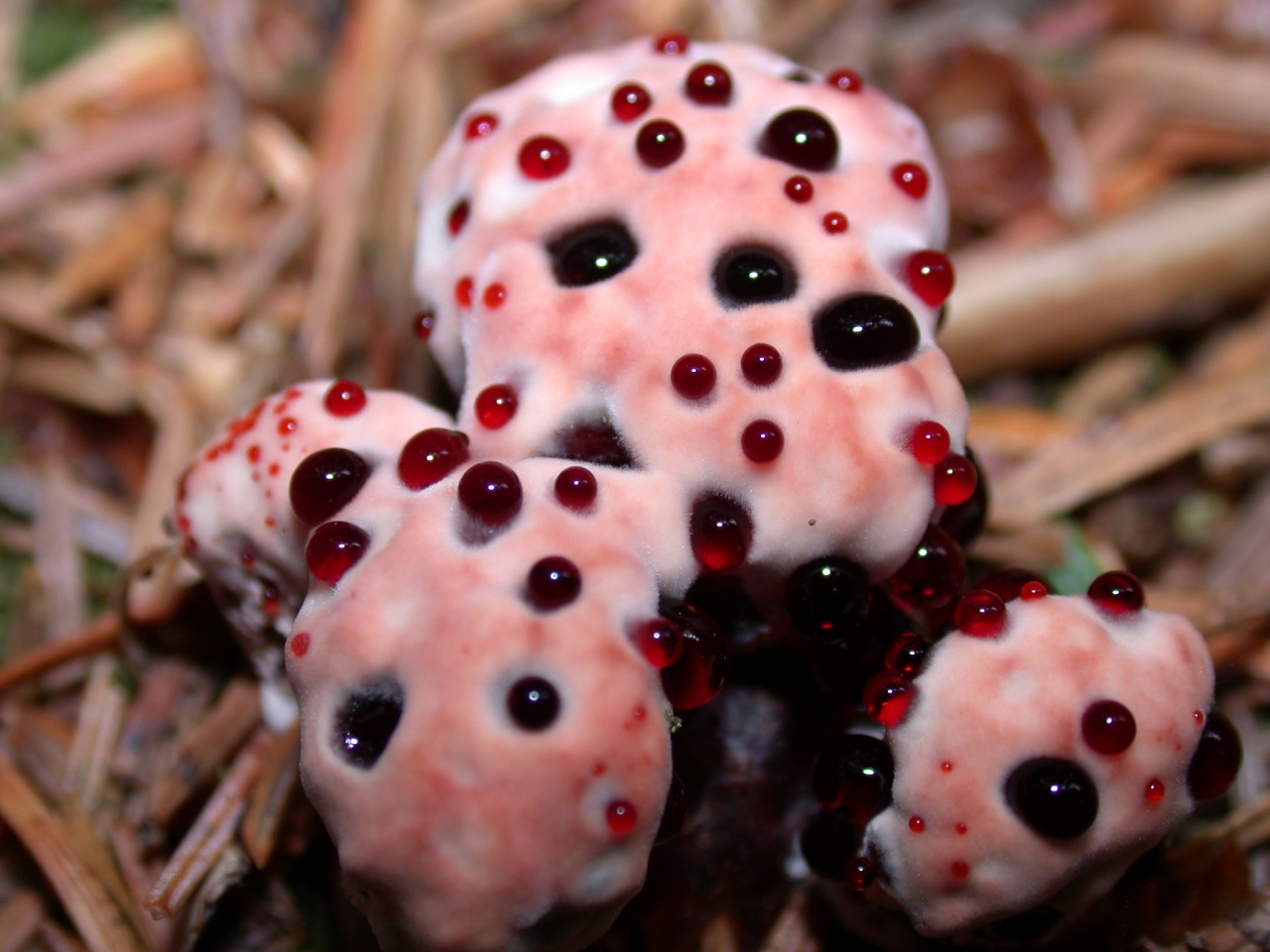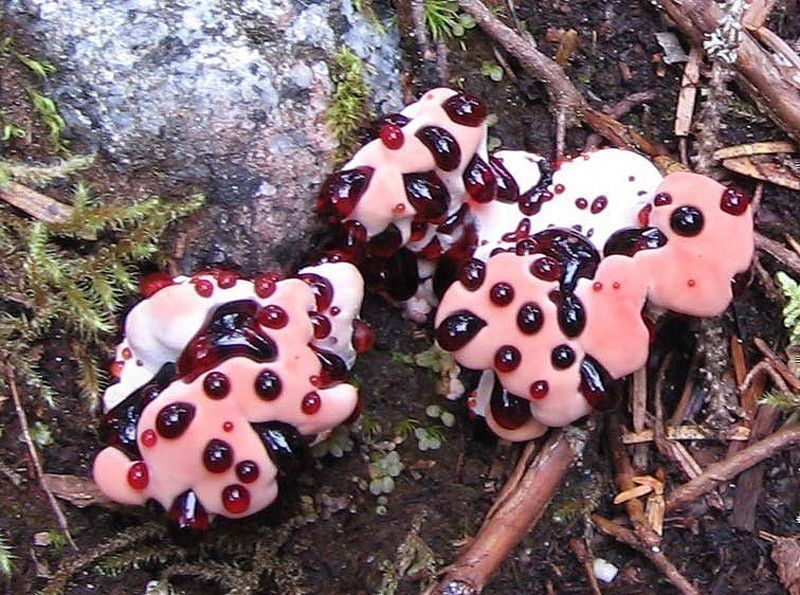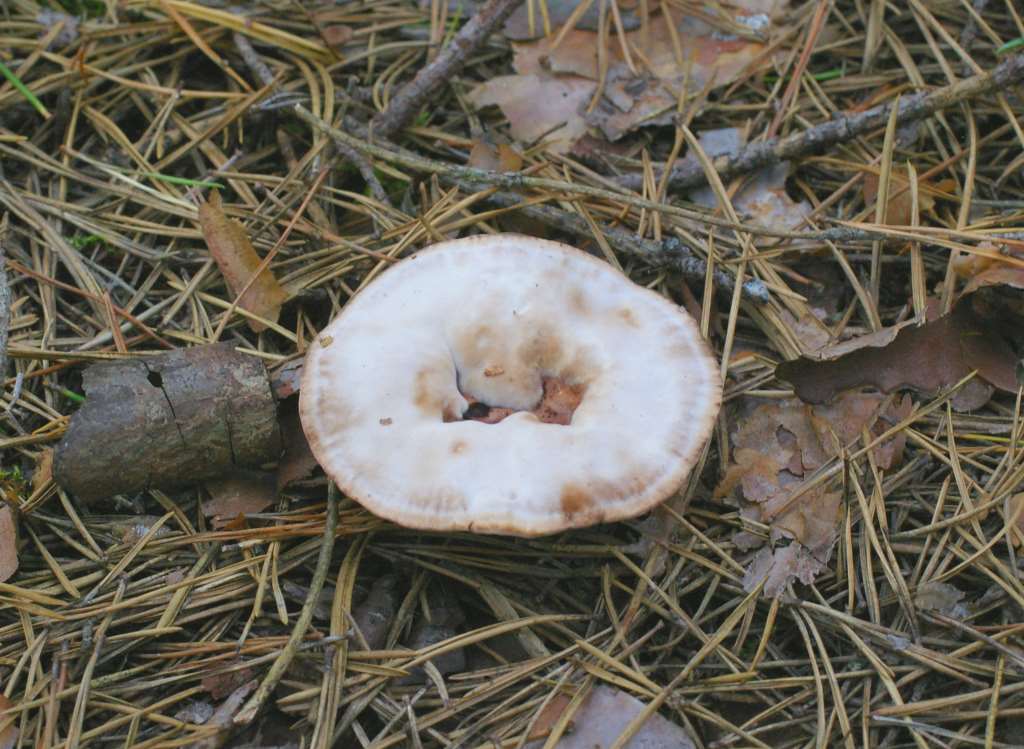Description
Gidnellum Peck was named after the writer and explorer Charles Peck, who first described his find in the middle of the 19th century. The mushroom cannot be completely excluded from the category of useful and edible, since it is not toxic. The main feature of gidnellum is its appearance. In Alaska and North America, the locals nicknamed him "the bleeding mushroom", in Norway - "bloody tooth".
In Russia, this representative of the mushroom kingdom is extremely rare, only a few managed to find it on the high peaks of the Caucasus Mountains. Latin and international name - Hydnellum peckii. You can also find other nicknames:
- Killer Mushroom;
- Pretty mushroom;
- Cake;
- Devil's hedgehog.
Hat
The surface of the cap resembles the shape of a shell. Many experts compare it to gills or rotting fruit. This is understandable, since in adulthood, the Killer Mushroom looks frightening. The hat is very difficult to confuse with other types, because during the ripening period, "red juice" begins to ooze from it. Large drops on the white spongy surface indicate that the fungus belongs to the Banker family.
Hymenophore
The hymenophore is difficult to identify, since most of the fungus is occupied by a bright cap. However, if you look closely, then a scaly formation begins on the inside of the cap. It is this that is the hymenophore. In a young mushroom, it is soft, pronounced, white and has small scales. They can be compared to the bristles of the human tongue. During the ripening period, they increase in size and darken.
Pulp
The creamy pulp has a cork structure. If you cut the mushroom in half, it will pour out red juice, which is in the small hollow holes.
Leg
Gidnellum was nicknamed "Bloody Tooth" for a reason. The name is fully consistent with the species, since the leg of the fungus resembles the root of an adult tooth. Throughout its life, it barely reaches 3 cm in length. Most of it is in the soil.
External description
The fruiting body of rusty hydnellum is hat-stem.
Hat. The diameter of the cap is 5-10 cm. In young specimens it has a clavate shape, in mature mushrooms it becomes reverse conical (sometimes funnel-shaped or flat in some specimens).
The surface is velvety, with many irregularities, often covered with wrinkles, whitish in young mushrooms. Gradually, the surface of the cap becomes rusty brown or pale chocolate. It clearly shows purple droplets of a protruding liquid, which dries up and leaves brown spots on the cap of the fruiting body.
The edges of the cap are even, white, and brown with age. The mushroom pulp is two-layer, near the surface it is felt and loose. It is best developed near the base of the stem, and in this area it has a lighter color. In the center of the cap of rusty hydnellum, the texture of the tissues is leathery, cross-zoned, fibrous, rusty-brown or chocolate shade.
During growth, the fruiting body of the fungus, as it were, "flows around" the obstacles encountered, for example, twigs.
Hymenophore characteristics. A spiny hymenophore, consisting of spines descending slightly down the pedicle. at first they are white, gradually becoming chocolate or brown. They are 3-4 mm long, very brittle.
Spines near:
Leg. The height of the rusty gidnellum leg is 5 cm. It itself is completely covered with a rusty-brown soft cloth and has a felt structure.
Microscopic signs. Thin-walled hyphae have slightly thickened walls, do not contain buckles, but there are septa. Their diameter is 3-5 microns, there is a minimum color. Near the surface of the cap, you can see a large accumulation of brownish-red hyphae with blunt ends.Rounded warty spores are characterized by a slightly yellowish color and 4.5-6.5 * 4.5-5.5 microns in size.
Description
Fruit bodies are simple or fused, with a flattened or depressed, usually uneven, velvety-scaly cap up to 6.5 cm in diameter. The hat is painted in white tones, with age it acquires a red-black, violet-black or brown, less often a dark blue tint, often with concentric zones.
Leg 0.5-6 × 0.5-2 cm, cylindrical or fusiform, whitish, then the same color with a cap.
The hymenophore is thorny, the spines are up to 5 mm long, at first white, then darken to light lilac or brownish.
The flesh is light, pinkish-brown or light brown, darker in the stem than in the cap, with noticeable yellowish veins. The taste is bitter and strong.
Grows in autumn on the ground in coniferous (spruce and pine) forests. Inedible due to strong bitter taste.
What can be confused with a bleeding mushroom
There are several varieties of hydnellum that the bleeding mushroom looks like:
- Gidnellum blue. Another inedible specimen that grows mainly in the northern part of the European hemisphere. It is located in coniferous forests, chooses sunny places with a large accumulation of white mosses. Usually, the fruits settle alone, bearing fruit from July to September. The cap of the mushroom can reach 20 cm in diameter, the height of the stem does not exceed 12 cm. On the uneven surface of blue hydnellum, you can see bulges resembling bumps. In young specimens, the cap is slightly velvety. The name of the fruit is due to the fact that the upper part of the cap is painted in a bluish tint, while the bottom part is more saturated, darker color. The leg is brown in color. The pulp is firm, stiff. It is characterized by neither a pronounced smell, nor a tangible taste.
- Hydnellum odorous. Also an inedible specimen, like all previously described breeds. Has a lumpy fruit body, which can be concave, and a velvety surface. Young mushrooms are white, but over time it becomes noticeably darker. This variety also tends to emit red droplets. They also appear through the pores that densely cover the cap. On the lower part (where the hymenophore is usually located), bluish thorns can be seen. The leg of the odoriferous gidnellum has a conical shape. The spores are brown. Despite its name, this mushroom has an unpleasant odor. The fruiting period does not last very long. Mushrooms grow mainly in autumn. They settle near spruce and pine trees on sandy soil.
All varieties of gidnellum look unusual and outwardly very attractive. You can just admire them and nothing more. It is not recommended to bring them home even as a decorative element, especially if there are small children. Even accidental ingestion of the poison contained in the juice of the mushroom poses a serious danger to life!
Mushroom "Bloody Tooth" - the most interesting facts about hydnellum pitch
An interesting representative of the mushroom kingdom is mushroom bloody tooth, named for its unconventional look. It was first written about in 1913, although it was found much earlier (1812). But even now it remains a mystery to scientists, since it has not yet been fully investigated.
Synonyms: there are many other names, in some it is associated with berries in sour cream - "strawberries and cream" (strawberries and cream), a mushroom on which raspberry syrup was poured, "a tooth with red juice", and to some it resembles a gum with a berry filling , "Devil's tears", devil's mane, bleeding hedgehog, devil's tooth, tooth fungus, the red-juice tooth, devil's tooth. Most commonly referred to as bleeding tooth fungus.
Appearance (description)
With its appearance, a mushroom A bleeding tooth can greatly scare or, conversely, interest, depending on what it will be associated with.With their appearance, individuals not only attract people, but also lure insects, from which a wonderful "dinner" is made. The fruit body is whitish, velvety, but over time it becomes brownish.
Fruit body. Its white (slightly pink) velvet cap has a bizarre shape with small depressions, on which bright red droplets flaunt, passing through the pores. Most people associate them with blood. With age, growths appear along the edges (very similar to teeth). Hence the name Bleeding Tooth.
The cap is whitish-pinkish of irregular shape, usually 5-7 cm in diameter (with the exception of 10 cm). With aging, the cap changes from an attractive whitish and fleshy cork to a red-black and then brown cork.
The leg of this representative is very small - 2 cm (in the form of a cone), whitish (matching the color of the cap), it is almost invisible and, if you look closely, you can see how skillfully it “hid” in the moss or in the ground.
A brown spore powder is found on numerous needles on the bottom of the mushroom.
The pulp is white, but darkens with age. Always a little darker closer to the stem.
Smell and taste. The smell is almost imperceptible, although it may seem like it smells like strawberries. Bitter taste. You do not need to try the mushroom, as it is poisonous. Anyone who wants to test how hydnellum pitch mushroom tastes or its red liquid similar to raspberry or strawberry jam will die.
Growth time
It is rare to meet gidnellum pitch or a bleeding mushroom in our area, but it grows in the autumn months from September to November.
Where the Bloody Tooth Mushroom Grows
This mushroom can only be seen in coniferous forests. The countries with the most favorable conditions for its growth are in North America, Australia and central Europe. It is also found in the Pacific Northwest, Korea and Iran. In the CIS countries, it is extremely rare to find a bleeding tooth, although the climate is constantly changing and therefore new types of fungi appear where they have never been before, and some, on the contrary, disappear.
Hydnellum pitch prefers sandy soils because they absorb moisture better. Loves "loneliness", because of this, and is found in most cases as a single specimen, although you can also find a small group.
Edibility
Hydnellum pitch is an inedible poisonous fungus. Many consider it extremely poisonous, which can be killed by licking a single red drop. But if the toxicity of a substance in a red liquid is still being studied, then it is already known for sure that the pinkish cap contains poisonous substances and is dangerous to human life.
Healing properties
On the farm, it was once used to create a dye. It also has beneficial properties, namely antibacterial properties. It contains the pigment atromentin, which is highly valued in medicine, as it can cure many people suffering from blood clots. With its help, you can easily avoid the formation of blood clots. But, unfortunately, this mushroom is not yet used in medicine, although they believe that very soon they will receive miraculous drugs, as they previously received the antibiotic penicillin from the fungus Penicillium notatum.
Similarities with other species
Since the bloody tooth fungus differs from all representatives of the mushroom world due to the red liquid, it is very difficult to confuse it with other individuals. Outwardly, it may resemble milk mushrooms.
Description of hydnellum pitch
Gidnellum pitch is a mushroom belonging to the Bunker family and the Gidnellum genus. The name is fully consistent with the characteristics of the specimen, as it translates as "bleeding tooth". This fruit was first identified and described in 1812.
What does it look like
The surface of the mushroom is abundantly strewn with red dots, like drops of blood. But if you look closely, you will notice that this is not blood, but simply juice that oozes through the pores located in the hydnellum cap.The fruit has some similarities with the usual edible raincoat, which was previously watered with currant juice or maple syrup.

For its unusual, "bloody" species, the mushroom got the name "devil's hedgehog". Also, this name can be explained by the extreme toxicity of this mushroom specimen.
The structure and features of the species hydnellum peckii
This mushroom is not like other species, however, its structure is the same. That is, the structure of gidnellum is formed:
- With a hat. It has an irregular shape, tubercles are visible on its surface. This is what gives it the appearance of a human tooth. In a young specimen, the cap surface is white or light pink. There are numerous red dots on the top of the cap, which are balls filled with liquid. In humid weather, saping is more intense. On average, the diameter of the cap is 5 cm. But in exceptional cases, and only in old hydnellums, it can grow up to 10 cm in circumference. As the life cycle of the fungus is completed, its cap becomes darker, brown, color. If you turn the specimen over and look at the lower part of its cap, you can see that it is studded with small thorns.
- The pulp. At first it has a dense structure, but over time it becomes like a cork. The color of the pulp is light brown or pinkish. It tastes bitter, but it does not have a pronounced smell. Although, if you study it more closely, you get the feeling that it smells like strawberries.
- With a leg. It is very small, moreover, it is located deep in the moss or underground. Has the same color as the hat, but conical in shape.
As the mushroom ages, the edges of the mushroom cap acquire sharp protrusions, which make it look like a tooth.
Remember, although gidnellum looks attractive, it is not edible. Moreover, the mushroom is very poisonous and can be easily poisoned. The mortality rate when using this specimen is almost one hundred percent! It is the drops that are located on the cap surface of the fruit that contain the deadly poison.
Habitat and distribution
Fruit bodies Hydnellum peckii found solitary, scattered or clustered together on the ground under conifers, often among mosses and pine debris. H. peckii is a "late stage" fungus that, in arctic forests dominated by the Banks pine, tends to bind to more mature hosts as soon as the canopy is closed. A preference for mountainous or subalpine ecosystems has been noted.
The fungus is widely distributed in North America and is especially common in the Pacific Northwest; its range extends north to Alaska and east to North Carolina. In the Puget Sound area of the US state of Washington, it is found in collaboration with pseudo-tree, spruce and hemlock. Along the Oregon coast, it has been harvested under a stubble pine. In addition to North America, the mushroom is widespread in Europe, and its presence has been reported in Italy, Germany and Scotland. The species is common in the latter location, but becoming more and more rare in several European countries such as Norway, the Netherlands and the Czech Republic. Increased pollution in Central Europe has been suggested as one possible factor in the decline of the fungus there. Reports from Iran in 2008 and Korea in 2010 were the first outside Europe and North America.
Grabovik - description, where it grows, the poisonousness of the mushroom
The hornbeam is so named after the hornbeam tree, near which it most often grows. But he also has other names - gray or elm boletus, gray boletus. This mushroom is so similar to the boletus that mushroom pickers cannot always distinguish them.

Characteristic of appearance
The hornbeam belongs to the bolet family. His family is obabok.
In young mushrooms, the shape of the cap is hemispherical, with tucked edges.At a more mature age, the cap takes on a cushion shape. The surface is slightly wrinkled, has irregularities. The porous layer is up to 3 cm. The skin is dull and dry, but if it rains, it immediately becomes shiny and looks watery. Therefore, in comparison with the boletus, it loses due to the not such high-quality density of the cap. If the mushroom is overripe, the skin shrinks completely, and then the flesh of the cap, as well as the tubules, are noticeable under it.
The flesh of a young specimen is usually white and soft. But the older generation of hornbeams acquires stiffness with age, which differs significantly from the boletus. When the mushroom is cut, it darkens to a pink-purple color and then turns dark gray. But the aroma and taste of the mushroom are pleasant.
The color of the leg is grayish, but below it changes to brownish. It has a cylindrical shape, which becomes thicker closer to the ground. The pulp in it is fibrous. The thickness of the leg is on average 4 cm, the height is from 5 to 13 cm. The porous layer is free. It has a small notch located at the leg.
The shape of the spores is fusiform, and the spore powder has a brown tint. The pores are very small with an angularly rounded shape, their surface is white or sandy. The tubes are narrow, have a soft consistency with a watery structure.
Where can you find a grabber
Of course, where hornbeams grow, you can also find a hornbeam. But since these trees belong to the birch genus, gray boletus are often found in birch groves. These mushrooms also grow near other deciduous trees, for example, it can be hazel and poplar.
The most common habitats are the northern zones of Russia and Asia, the Caucasus. You can collect the hornbeam already in June, and its collection ends in October.
Grab set as food
This mushroom is ranked as edible, and in terms of taste it is very similar to boletus. But due to the fact that its pulp is less dense, it cannot be stored for a long time, it quickly deteriorates.
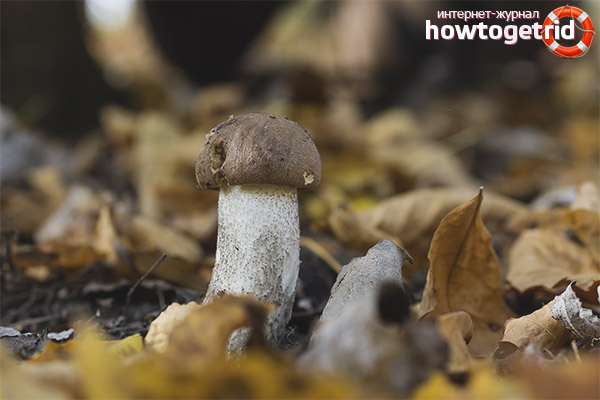
These mushrooms are especially fond of worms, so many should not be eaten due to the fact that they turn out to be eaten. After collection, you should carefully sort them at home and leave only fresh and healthy. If some parts are darker in color, then this may be evidence of decay, which is dangerous not only for health, but also for life.
Grab is used fresh to fry and boil, dried, soaked in vinegar and salt, pickled. For the preparation of various dishes, recipes are used that are applicable to boletus.
Similar mushrooms
The hornbeam has a similarity (and quite a lot) both with some edible mushrooms and with those that are dangerous to humans.
The gall mushroom is also a double of the hornbeam, but this is already its "antipode", since it is considered almost poisonous. It is not suitable for food because it tastes bitter. Even if you try to get the bitterness out of him, nothing will work, it will only intensify. Such mushrooms most often grow in forests with coniferous vegetation, as well as on sandy soils. Their time of existence is from July to October. Their cap is convex, with an average diameter of 10 cm. In a gall fungus, the surface of the cap is smooth and dry. The color is brown or brown. The pulp is white, thick. When cut, it takes on a pink tint. It has no smell, but you should not try it: it is very bitter. The leg can be up to 7 cm in length, from 1 to 3 cm in width. It differs in that it is swollen and dark brown or creamy-buffy, a mesh pattern is visible.
Where does the Bloody Tooth grow, in what forests
The beginning of fruiting of gidnellum falls on August, and the end - in late autumn. More precisely, the life cycle of the fungus ends with the onset of severe persistent frosts.
A notable feature of this specimen is the way it is fed. It not only absorbs soil juices, but also feeds on insects that settle on its surface. They are attracted by the red nectar droplets of hydnellum, which, due to their bright color, are clearly visible in the forest.
In 2012, this specimen was found in Buryatia.And the most interesting thing is that ordinary summer residents stumbled upon him, who sent them to pick mushrooms in the vastness of the vicinity of the gardening "Geologist", located in the Ivolginsky region.
Similar species
Closely related and also inedible hydellums are most similar to Hydellum Peck:
- rusty (Hydnellum ferrugineum). It can be confidently distinguished at the stage of maturity, when the initially light fruiting body with drops of purple liquid on the surface acquires a characteristic rich rusty-brown "tan";
- blue (Hydnellum caeruleum), which grows among white mosses in northern European forests. Also emits “bloody” drops, but has a distinct blue color. The center of the cap turns brown with age.
- odorous (Hydnellum suaveolens). Light fruiting bodies with bluish spines darken with age and have a rather pungent odor. At all stages of development, no colored liquid is emitted.
Habitat
The fruiting bodies of Hydnellum peckii have been found to grow alone, scattered or clustered together on the ground under conifers, often among mosses and needles.
The fungus is widespread in North America, especially in the Pacific Northwest. Its range extends north to Alaska, and east to North Carolina. In the Puget Sound area of Washington, USA, it is found in combination with Douglas Fir, Fir, and Hemlock. Along the Oregon coast, he was found under a pine tree. In addition to North America, the mushroom is widespread in Europe, and its presence has been documented in Italy, Germany, and Scotland. He meets him in other European countries, but much less often. The increase in pollution in central Europe has been suggested as one of the possible factors for the decline in the fungal population. The reports of the finding of mushrooms from Iran in 2008 and Korea in 2010 were the first outside Europe and North America.
Interesting facts about hydellum
Gidnellum got its second name (pitch) after the famous American mycologist Charles Horton Peck.
Despite the fact that this fruit is poisonous, it cannot be called extremely harmful. It contains substances with antibacterial properties. To date, active development of a serum based on the venom of this mushroom is underway.
Curious! Experts say that a drug made on the basis of gindellum can surpass even the well-known penicillin in effectiveness. However, so far these are only assumptions.
But it is reliably known that the fruit is used as a dye. So, if you do not add a special substance to the mixture with its content - a stain - then the color will be beige. And if you apply a stain, then the shade will turn blue or green (depending on the amount of the additional element).

Gidnellum pitch is not known to everyone, including experienced mushroom pickers who have been fond of quiet hunting for many years. At first, its distribution area was limited, but in recent years, the fruit has increasingly begun to be found in places where it was not found. There are known cases when mushroom pickers of St. Petersburg saw him, but whether this is really so, or whether they confused him with another fruit, is still a mystery.

